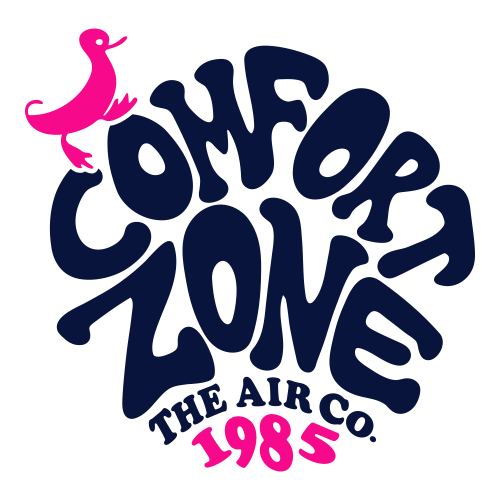
Your entire home should be a refuge that’s warm and cozy in the winter and cool and comfortable in the summer. However, residents in some homes with multiple levels find the upper floor is stubbornly hotter or colder than the rooms on ground level.
This could just be because most thermostats in a house are on the main floor, which is where people spend the greatest amount of time—in the living room, kitchen, etc.—so they set the temperature according to how it feels on the first floor.
However, temperature variations between the upstairs and downstairs could also be caused by problems with your HVAC system. Some of these challenges can be resolved relatively quickly while others might necessitate more extensive and costly fixes. Here, the team at Comfort Zone, LLC will help you figure out why the upstairs of your home is hotter than downstairs, or vice versa.
Why Is It Hotter Upstairs?
The phenomenon of the upstairs of a two-story home becoming hotter than the downstairs can be chalked up to several factors. For starters, heat rises, so it’s natural for the second floor of a home to get hotter than the first floor. Not enough insulation in the attic or roof can exacerbate this issue by letting heat transfer from the roof into the upstairs rooms.
Another common reason is that the HVAC system is not powerful enough to cool the entire home, causing it to struggle to cool the upstairs properly.
To tackle these issues, homeowners could install extra insulation in the attic and make sure their home has sufficient ventilation. If there’s a question of whether the air conditioner is the right size for the home, call an experienced HVAC company like Comfort Zone, LLC inspect the unit. A qualified professional also can help find a unit that's better suited for your home if you need air conditioning installation or replacement.
Why Is My Upstairs Always Cold/Not Heating?
When the downstairs of your home is warm, but it’s freezing upstairs, that makes for a frosty night for anyone whose bedrooms are on the upper floor. The most prevalent causes of an upstairs not heating like it should are the insulation levels and the ductwork.
Inadequate insulation permits cold air to seep through the home’s attic or walls and contribute to heat loss, creating colder temperatures on the upper levels. It’s essential to make sure your home has a deep, level layer of insulation in the attic and adequate insulation in the walls to keep the cold out and the heat inside.
The ductwork in a home plays a critical role in disseminating conditioned air throughout different locations of the building. However, problems with the ductwork can cause the upstairs being colder than the lower floor. A frequently reported reason for this is improper airflow balance. The ducts may not be the proper size or configuration, which results in an uneven distribution of air between the floors. This can cause more warm air to go downstairs, causing insufficient airflow—which is the heated air—on the higher floors.
Another possible issue with the ductwork is the placement of the supply and return vents. If there are fewer vents on the upper floor or they are poorly installed, it can reduce air circulation and cause substandard heating or cooling. Also, leaks or gaps in the ductwork can allow air loss, lowering the overall efficiency of the HVAC system and exacerbating the temperature difference.
To find out why the upstairs is colder than the downstairs, homeowners should hve their ductwork checked by skilled professionals like the team at Comfort Zone, LLC to identify any imbalances, leaks or inadequacies. Sealing leaks and adding new vents or adjusting existing ones can help increase airflow and ensure a better temperature balance between the upstairs and downstairs.
How You Can Fix a Hot or Cold Upstairs?
If your upstairs is hotter or colder than the lower floors of your house, an HVAC zoning system could be a highly effective solution.
An HVAC zoning system separates the home into different zones, which each have their own thermostat and damper system so the homeowner can customize the heating or cooling of each zone.
This system can be very effective in situations where the upstairs of a multi-story home is quite hot or extremely cold while the main floor is comfortable. By setting up a zoning system, homeowners can control the temperature independently in each zone, making it possible for them to address specific hot or cold spots effortlessly.
To discover more about an HVAC zoning system in Cape Coral, call Comfort Zone, LLC. We’ve designed and installed customized home comfort plans for many community members and are happy to show how an HVAC zoning system could enhance the comfort in your home.
Why Is it So Humid Upstairs?
In addition to the upper story being hotter or colder than the rest of the house, another problem in multi-floor homes is when the upstairs is more humid than the first floor.
A typical explanation for excess upper floor humidity is poor ventilation on the upper floor, which can produce greater humidity levels. As is often the case with temperature differences between floors, inadequate insulation or sealing in the attic or walls may permit warm, humid air from outdoors infiltrate the upstairs rooms. Plus, if there are any leaks or plumbing concerns on the upper floor, that can also cause excess moisture in that section of a home.
To correct humidity problems, homeowners can add more ventilation by installing fans or opening windows to promote airflow. Proper insulation in the attic and better sealing the attic and walls can help stop external moisture from entering the upstairs. Identifying and repairing any leaks or plumbing issues is also critical.
Depending on the levels of moisture found in the home, a whole-home dehumidifier could be another helpful tool to control humidity in the residence.
